탈모증, Alopecia
소아청소년(0~18세) 탈모증의 종류
1) 영유아들에게서 생길 수 있는 와위 탈모증(사진 418 참조)
2) 와위 생리 탈모증
3) 텔로젠 탈모증(모발의 성장기 중 휴지기에 빠지는 탈모증)
4) 특발성 원형 탈모증(사진 406, 407, 408, 409, 413, 414 참조)
5) 견인성 탈모증
6) 두부 백선 등 진균 감염으로 생기는 탈모증(사진 411, 412 참조)
7) 발모광(발모 벽, 모발 발거증)으로 인한 탈모증 등(사진 416 차조)
8) 사춘기 이후부터 안드로젠(안드로겐) 탈모증
9) 압박성 탈모증
10) 매독성 탈모증
11) 성장기 탈모증
12) 반흔성 탈모증
13) 그 외 탈모증
14) 존상원 이 증후군- 원형성 탈모+갑상선 항진증+ 복시
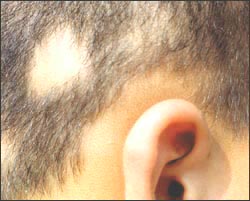
사진 406. 특발성 원형 탈모증.
Copyright ⓒ 2012 John Sangwon Lee, MD. FAAP
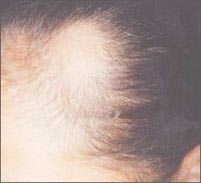
사진 409. 특발성 원형 탈모증.
Copyright ⓒ 2012 John Sangwon Lee, MD. FAAP
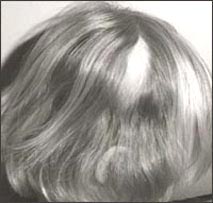
사진 407. 특발성 원형 탈모증.
Copyright ⓒ 2012 John Sangwon Lee, MD. FAAP

사진 408. 특발성 원형 탈모증.
Copyright ⓒ 2012 John Sangwon Lee, MD. FAAP
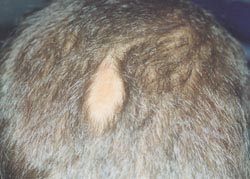
사진 410. 선천성 두 무피부증.
선천성 두 무피부증은 선천성 두피 결손증의 일부이다.
Copyright ⓒ 2012 John Sangwon Lee,MD. FAAP
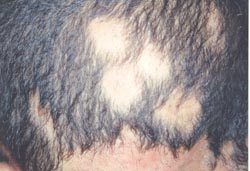
사진 41. 진균 감염성 두부백선으로 생긴 탈모증.
Copyright ⓒ 2012 John Sangwon Lee, MD. FAAP

사진 412. 진균 감염성 두부 백선으로 생긴 탈모증.
Copyright ⓒ 2012 John Sangwon Lee, MD. FAAP
탈모증의 원인
- 건강한 소아청소년의 두피에 나 있는 두발의 수가 약 십만 개다.
- 그 중 90%는 계속 자라고 있는 상태이고, 나머지 10%는 다 자란 상태에 있거나 빠지고 있는 상태에 있는 것이 정상적이다.
- 아무 병이 없이 하루 두발 50~100개 정도는 정상적으로 빠질 수 있다.
- 하루에 두발 100개나 그 이하 빠지는 것은 정상적이다.
- 전체 두발 중 25~50%정도 빠지면 두발이 비정상적으로 빠지는 것을 쉽게 육안으로 감지될 수 있다.
탈모증이 다음과 같은 경우 생길 수 있다.
- 인플루엔자나 호열자 등 감염병으로 고열이 나면서 심하게 앓을 때 탈모증이 생길 수 있다.
- 수술 치료
- 약물 치료 ,
- 갑상선 기능 저하증,
- 정신적 문제와 심한 스트레스,
- 하시모도 갑상선염,
- 백반증,
- 매독,
- 약물중독,
- 교원병,
- 악성빈혈,
- 발모 광(발모 벽),
- 두부 백선,
- 견인성 탈모,
- 전염성 두피질환,
- 선천성 두피 기형(사진 410 참조)
- 자가면역 질환
- 그 외
사춘기 이전 소아들에게 비교적 흔히 볼 수 있는 탈모증
- 텔로젠 탈모증(모발의 성장주기 중 휴지기에 빠지는 탈모),
- 특발성 원형 탈모증,
- 견인성 탈모증,
- 두부 백선,
- 발모 광(발모 벽, 모발 발거증) 등.
안드로젠(남성 호르몬) 탈모증이 사춘기 이후부터 생길 수 있다.
소아청소년들에게서 비교적 흔히 볼 수 있는 탈모증
- 원형 탈모증,
- 두부 백선 탈모증,
- 견인성 탈모증,
- 발모 광,
- 안드로젠 탈모증,
- 휴지기 탈모증,
- 상흔성 탈모증
등에 관해 각 항에서 더 구체적으로 설명한다.
|
다음은 “7살 애 머리카락이 많이 빠지는데요, 탈모증”에 관한 인터넷 소아청소년 건강상담 질의응답의 예 입니다. |
Q&A. 7살 애 머리카락이 많이 빠지는데요, 탈모증
Q.
7살 큰애 머리카락이 얼마 전부터 많이 빠지는데 이유를 모르겠네요.
너무 많이 놀아서 그런가보다 하지만 못 놀게 할 수도 없고 머리를 감거나 빗을 때 툭툭 떨어지는데 평소에는 빗거나 감아도 머리카락이 별로 없는데 이번엔 많이 빠지네요.
검사를 받아봐야 하나요?
큰애는 피곤하고 몸이 안 좋으면 피오줌을 싸는데 작년에 대학병원에서 검사받았지만 단백과 칼슘이 좀 많이 나온다고 하고선 약도 처방 안 해주고 또 피나오면 검사받으러 오라고만 하기에 안 갔습니다. 이것도 영향이 큰지요?
A.
언니님
안녕하세요.
질문해 주셔 감사합니다.
나이, 성별, 과거, 현재, 가족의 병력, 진찰소견, 임상검사 결과 등 많은 정보가 있으면 더 좋은 답변을 드릴 수 있습니다. 주신 정보를 토대로 답변을 드립니다.
머리카락이 빠지는 원인은 아주 많이 있습니다.
탈모증,원형 탈모증,두부 백선, 견인성 탈모증,발모 광,
안드로젠 탈모증, 휴지기 탈모증, 상흔성 탈모증, 와위 탈모증과 그 외 다른 종류의 탈모증 등을 참조하시기 바랍니다.
고칼슘혈증이 있을 때도 소변에 피가 나올 수 있습니다.
그렇지만 소아청소년에서 피 오줌(혈뇨)을 누는 원인들 중 가장 흔한 원인은 요로 감염입니다.
[부모도 반의사가 되어야 한다–소아가정간호 백과]-제 10권 소아청소년 신장 비뇨 생식기계 질환–요로 감염을 참조하시기 바랍니다.
그리고 때로는 여러 번 반복해서 소변검사를 하고 또 신장, 요관, 방광 등의 초음파 검사, CT 스캔 검사 등을 꼭 해서 확실히 진단을 받고 그에 따라 치료를 해주어야 할 것 같습니다.
소변 딥스틱 화학검사, 그람 염색 현미경 세균검사 그리고 세균 배양검사를 꼭 하셔야 될 것 같습니다.
소아청소년과에서 두 자녀분이 다 진찰 진단을 받으시고 그 문제에 관해 상담하시기 바랍니다. 질문이 더 있으면 또 방문하세요. 감사합니다. 이상원 드림
Alopecia
Types of alopecia in children and adolescents (0-18 years old)
1) Causal alopecia that can occur in infants and young children (see photo 418)
2) Cochlear menstrual alopecia
3) Telogen alopecia (alopecia that falls in the telogen phase of hair growth)
4) idiopathic alopecia areata (see photos 406, 407, 408, 409, 413, 414)
5) Traction alopecia
6) Alopecia caused by fungal infection such as ringworm of the head (see photos 411 and 412)
7) Alopecia due to baldness (hair wall, hair loss), etc.
(Picture 416)
8) Androgen (androgen) alopecia since puberty
9) pressure alopecia
10) Syphilitic Alopecia
11) Growth phase alopecia
12) Scar alopecia
13) Other alopecia
14) John Sang-won Lee Syndrome- Alopecia areata + Hyperthyroidism + Diplopia

Photo 406. Idiopathic alopecia areata. Copyright ⓒ 2012 John Sangwon Lee, MD. FAAP

Picture 409. Idiopathic alopecia areata. Copyright ⓒ 2012 John Sangwon Lee, MD. FAAP

Picture 407. Idiopathic alopecia areata. Copyright ⓒ 2012 John Sangwon Lee, MD. FAAP

Picture 408. Idiopathic alopecia areata. Copyright ⓒ 2012 John Sangwon Lee, MD. FAAP

Picture 410. Congenital andermatosis of the scalp. Congenital andermatosis of the scalp is part of the congenital scalp defect. Copyright ⓒ 2012 John Sangwon Lee, MD. FAAP

Picture 41. Alopecia caused by fungal infection of ringworm of the head. Copyright ⓒ 2012 John Sangwon Lee, MD. FAAP

Picture 412. Alopecia caused by fungal infectious ringworm of the head. Copyright ⓒ 2012 John Sangwon Lee, MD. FAAP
Causes of alopecia
• About 100,000 hairs on the scalp of healthy children and adolescents.
• It is normal for 90% of them to continue to grow, and the remaining 10% to be fully grown or falling out. • About 50 to 100 hairs per day can normally fall out without any disease.
• It is normal to lose 100 or fewer hairs per day.
• If about 25-50% of the total hair falls out, abnormal hair loss can be easily detected with the naked eye.
Alopecia can occur when:
• Alopecia can occur when you are seriously ill with a high fever due to an infectious disease such as influenza or fever.
• Surgical treatment
• Medication;
• hypothyroidism;
• Mental problems and severe stress;
• Hashimodo thyroiditis;
• Vitiligo;
• Syphilis;
• drug addiction;
• Teacher soldiers;
• pernicious anemia;
• Hair regrowth (hair regrowth wall),
• Ringworm of the head;
• Traction alopecia;
• Infectious scalp diseases;
• Congenital anomalies of the scalp (see photo 410)
• Autoimmune diseases
• etc
Alopecia, which is relatively common in children before puberty
• Telogen alopecia (hair loss that falls in the resting phase of the hair growth cycle),
• idiopathic alopecia areata,
• Traction alopecia;
• Ringworm of the head;
• Hair follicles (wall of hair, baldness), etc.
Androgen (male hormone) alopecia can occur after puberty.
Alopecia, which is relatively common in children and adolescents
• Alopecia areata,
• Ringworm of the head, alopecia;
• Traction alopecia;
• hair growth,
• androgenetic alopecia;
• telogen alopecia;
• Scar alopecia etc. will be described in more detail in each section.
The following is an example of Internet pediatric health consultation Q&A regarding “A 7-year-old girl loses a lot of hair, alopecia”.
Q&A. A 7-year-old girl loses a lot of hair, alopecia
Q. My 7-year-old eldest has been losing a lot of hair for a while now and I don’t know why. I think it’s because I’ve been playing too much, but I can’t stop playing, and it falls off when I wash or comb my hair. Normally, I don’t have much hair, but this time it falls out a lot. Should I get tested? My eldest son pees blood when he is tired and unwell. Last year, he was tested at a university hospital, but he said that he had a lot of protein and calcium, and he didn’t prescribe medication and only told him to come for a test if he had blood. Does this also have a big impact?
A. older sister Good morning.
Thank you for asking a question. We can give you a better answer if you have a lot of information such as age, gender, past, present, family history, examination findings, and clinical test results. We will respond based on the information you have provided. There are many causes of hair loss. Alopecia, alopecia areata, ringworm of the head, traction alopecia, hair loss, Please see androgenetic alopecia, telogen alopecia, scarring alopecia, supine alopecia and other types of alopecia. You may also have blood in your urine when you have hypercalcemia.
However, the most common cause of bloody urine (hematuria) in children and adolescents is a urinary tract infection. www.drleepediatrics.com – Please refer to Volume 10 Children and Adolescents Kidney and Urogenital System Disorders – Urinary Tract Infection.
And sometimes, it seems that it is necessary to do a urine test repeatedly several times, ultrasound examination of the kidney, ureter, bladder, etc., and a CT scan to make sure the diagnosis is made and treatment according to it. Urine dipstick chemistry test, Gram stain microscopic bacteriological test, and bacteriological test seem to be a must.
At the Department of Pediatrics, both children should be diagnosed and consulted about the problem. Please visit again if you have more questions. Thank you. Lee Sang-won .
출처 및 참조 문헌 Sources and references
- NelsonTextbook of Pediatrics 22ND Ed
- The Harriet Lane Handbook 22ND Ed
- Growth and development of the children
- Red Book 32nd Ed 2021-2024
- Neonatal Resuscitation, American Academy of Pediatrics
- www.drleepediatrics.com 제1권 소아청소년 응급 의료
- www.drleepediatrics.com 제2권 소아청소년 예방
- www.drleepediatrics.com 제3권 소아청소년 성장 발육 육아
- www.drleepediatrics.com 제4권 모유,모유수유, 이유
- www.drleepediatrics.com 제5권 인공영양, 우유, 이유식, 비타민, 미네랄, 단백질, 탄수화물, 지방
- www.drleepediatrics.com 제6권 신생아 성장 발육 육아 질병
- www.drleepediatrics.com제7권 소아청소년 감염병
- www.drleepediatrics.com제8권 소아청소년 호흡기 질환
- www.drleepediatrics.com제9권 소아청소년 소화기 질환
- www.drleepediatrics.com제10권. 소아청소년 신장 비뇨 생식기 질환
- www.drleepediatrics.com제11권. 소아청소년 심장 혈관계 질환
- www.drleepediatrics.com제12권. 소아청소년 신경 정신 질환, 행동 수면 문제
- www.drleepediatrics.com제13권. 소아청소년 혈액, 림프, 종양 질환
- www.drleepediatrics.com제14권. 소아청소년 내분비, 유전, 염색체, 대사, 희귀병
- www.drleepediatrics.com제15권. 소아청소년 알레르기, 자가 면역질환
- www.drleepediatrics.com제16권. 소아청소년 정형외과 질환
- www.drleepediatrics.com제17권. 소아청소년 피부 질환
- www.drleepediatrics.com제18권. 소아청소년 이비인후(귀 코 인두 후두) 질환
- www.drleepediatrics.com제19권. 소아청소년 안과 (눈)질환
- www.drleepediatrics.com 제20권 소아청소년 이 (치아)질환
- www.drleepediatrics.com 제21권 소아청소년 가정 학교 간호
- www.drleepediatrics.com 제22권 아들 딸 이렇게 사랑해 키우세요
- www.drleepediatrics.com 제23권 사춘기 아이들의 성장 발육 질병
- www.drleepediatrics.com 제24권 소아청소년 성교육
- www.drleepediatrics.com 제25권 임신, 분만, 출산, 신생아 돌보기
- Red book 29th-31st edition 2021
- Nelson Text Book of Pediatrics 19th- 21st Edition
- The Johns Hopkins Hospital, The Harriet Lane Handbook, 22nd edition
- 응급환자관리 정담미디어
- Pediatric Nutritional Handbook American Academy of Pediatrics
- 소아가정간호백과–부모도 반의사가 되어야 한다, 이상원 저
- The pregnancy Bible. By Joan stone, MD. Keith Eddleman, MD
- Neonatology Jeffrey J. Pomerance, C. Joan Richardson
- Preparation for Birth. Beverly Savage and Dianna Smith
- 임신에서 신생아 돌보기까지. 이상원
- Breastfeeding. by Ruth Lawrence and Robert Lawrence
- Sources and references on Growth, Development, Cares, and Diseases of Newborn Infants
- Emergency Medical Service for Children, By Ross Lab. May 1989. p.10
- Emergency care, Harvey Grant and Robert Murray
- Emergency Care Transportation of Sick and Injured American Academy of Orthopaedic Surgeons
- Emergency Pediatrics A Guide to Ambulatory Care, Roger M. Barkin, Peter Rosen
- Quick Reference To Pediatric Emergencies, Delmer J. Pascoe, M.D., Moses Grossman, M.D. with 26 contributors
- Neonatal resuscitation Ameican academy of pediatrics
- Pediatric Nutritional Handbook American Academy of Pediatrics
- Pediatric Resuscitation Pediatric Clinics of North America, Stephen M. Schexnayder, M.D.
-
Pediatric Critical Care, Pediatric Clinics of North America, James P. Orlowski, M.D.
-
Preparation for Birth. Beverly Savage and Dianna Smith
-
Infectious disease of children, Saul Krugman, Samuel L Katz, Ann A.
- 제4권 모유, 모유수유, 이유 참조문헌 및 출처
- 제5권 인공영양, 우유, 이유, 비타민, 단백질, 지방 탄수 화물 참조문헌 및 출처
- 제6권 신생아 성장발육 양호 질병 참조문헌 및 출처
- 소아과학 대한교과서
Reviewed 7/24/2014, 3/ 2015
부모도 반의사가 되어야 한다
www.koreapediatrics.com
Copyright ⓒ 2014 John Sangwon Lee, MD, FAAP
“부모도 반의사가 되어야 한다”-내용은 여러분들의 의사로부터 얻은 정보와 진료를 대신할 수 없습니다.
“The information contained in this publication should not be used as a substitute for the medical care and advice of your doctor. There may be variations in treatment that your doctor may recommend based on individual facts and circumstances.
“Parental education is the best medicine.